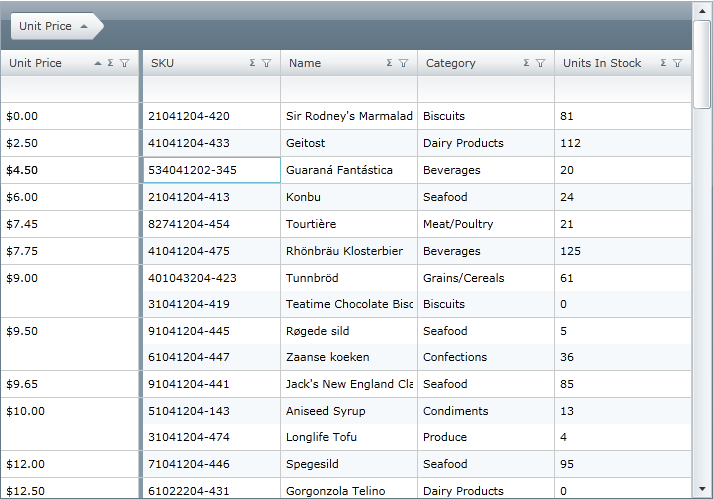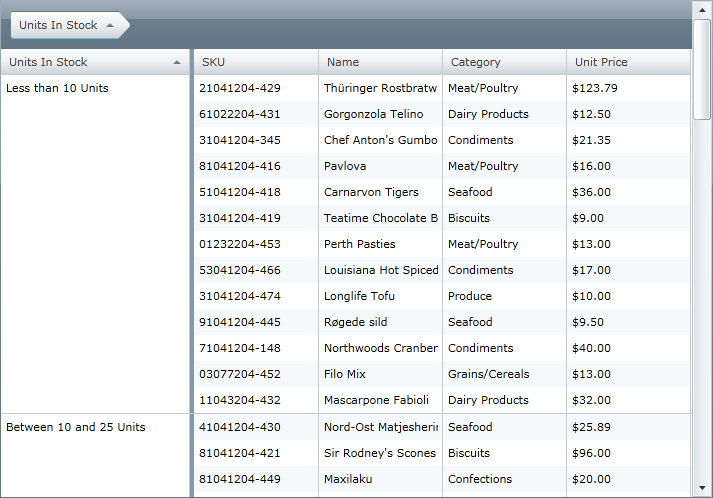
We recommend that you use the xamDataGrid control instead of the xamGrid control. The xamGrid is being planned for retirement over the next few years and will not receive any new features. We will continue to provide support and critical bug fixes for the xamGrid during this time. For help or questions on migrating your codebase to the xamDataGrid, please contact support.
The default behavior of the xamGrid control Merged Cells feature is to merge only the cells contain the same values. (The merged cells are placed in the merged column area.)
The following screen shot below displays the Unit Price column grouped in a grid using the default behavior of the cell merging feature:

Figure 1 The xamGrid control with Unit Price column grouped using default cell merging
However, you can override this default behavior and create groupings based on a custom condition.
This is achieved by creating a custom comparer that implements the generic IEqualityComparer interface and provides the type that matches the column’s underlying value. You configure the custom comparer with the GroupByComparer property of the xamGrid control.
The screen shot below displays a grid where the column is merged based on the following values:
Less than 10
Between 10 and 25
Between 25 and 50 units
Between 50 and 75 units
Greater than 75

Figure 2: The xamGrid control with Unit Price column grouped using default cell merging
The code below demonstrates how to set a column to merge values based on the values listed above. The example uses a custom comparer that implements the IEqualityComparer Interface for integers. It also uses the GroupedValuesConverter class which implements the IValueConverter interface to display a custom value for each merged cell.
In XAML:
<!-- Set up custom comparer-->
<ig:TextColumn Key="UnitsInStock" IsGroupBy="True" GroupByComparer="{StaticResource GroupByCustomComparer}">
<!-- Use data template to set custom caption for each merged column -->
<ig:TextColumn.MergedItemTemplate>
<DataTemplate>
<StackPanel Orientation="Horizontal">
<TextBlock Text="{Binding Value, Converter={StaticResource GroupedValuesConverter}}" />
</StackPanel>
</DataTemplate>
</ig:TextColumn.MergedItemTemplate>
</ig:TextColumn>
In Visual Basic:
Public Class GroupByCustomComparer Implements IEqualityComparer(Of Integer)
Public Function Equals1(ByVal x As Integer, ByVal y As Integer) As Boolean Implements System.Collections.Generic.IEqualityComparer(Of Integer).Equals
' Compares values for each group created by GetHashCode
' Since no additional conditions is required, just return true
Return True
End Function
Public Function GetHashCode1(ByVal obj As Integer) As Integer Implements System.Collections.Generic.IEqualityComparer(Of Integer).GetHashCode
' Compare value and return the same hashcode for each group
If obj >= 0 AndAlso obj < 10 Then
Return "0".GetHashCode()
End If
If obj >= 10 AndAlso obj < 25 Then
Return "10".GetHashCode()
End If
If obj >= 25 AndAlso obj < 50 Then
Return "25".GetHashCode()
End If
If obj >= 50 AndAlso obj < 75 Then
Return "50".GetHashCode()
End If
If obj >= 75 Then
Return "75".GetHashCode()
Else
Return obj.GetHashCode()
End If
End Function
End Class
In Visual Basic:
Public Class GroupedValuesConverter
Implements IValueConverter
Public Function Convert(ByVal value As Object, ByVal targetType As System.Type, ByVal parameter As Object, ByVal culture As System.Globalization.CultureInfo) As Object Implements System.Windows.Data.IValueConverter.Convert
' Get value to convert
Dim val As Integer = CInt(value)
' Compare value and returns a description of the value's range, displayed in each Groupby row
If val >= 0 AndAlso val < 10 Then
Return " Less than 10 Units "
ElseIf val >= 10 AndAlso val < 25 Then
Return " Between 10 and 25 Units "
ElseIf val >= 25 AndAlso val < 50 Then
Return " Between 25 And 50 Units "
ElseIf val >= 50 AndAlso val < 75 Then
Return " Between 50 And 75 Units "
ElseIf val >= 75 Then
Return "75 or Greater Units in Stock"
Else
Return val.ToString()
End If
End Function
Public Function ConvertBack(ByVal value As Object, ByVal targetType As System.Type, ByVal parameter As Object, ByVal culture As System.Globalization.CultureInfo) As Object Implements System.Windows.Data.IValueConverter.ConvertBack
Throw New NotImplementedException()
End Function
End Class
In C#:
public class GroupByCustomComparer : IEqualityComparer<int>
{
#region IEqualityComparer<int> Members
public bool Equals(int x, int y)
{
// Compares values for each group created by GetHashCode
// Since no additional conditions is required, just return true
return true;
}
public int GetHashCode(int obj)
{
// Compare value and return the same hashcode for each group
if (obj >= 0 && obj < 10)
return "0".GetHashCode();
if (obj >= 10 && obj < 25)
return "10".GetHashCode();
if (obj >= 25 && obj < 50)
return "25".GetHashCode();
if (obj >= 50 && obj < 75)
return "50".GetHashCode();
if (obj >= 75)
return "75".GetHashCode();
else
return obj.GetHashCode();
}
}
In C#:
public class GroupedValuesConverter : IValueConverter
{
#region IValueConverter Members
public object Convert(object value, Type targetType, object parameter, System.Globalization.CultureInfo culture)
{
// Get value to convert
int val = (int)value;
// Compare value and returns a description of the value's range, displayed in each merged column
if (val >= 0 && val < 10)
return “Less than 10 Units”;
else if (val >= 10 && val < 25)
return “Between 10 and 25 Units”;
else if (val >= 25 && val < 50)
return ”Between 25 And 50 Units”;
else if (val >= 50 && val < 75)
return ”Between 50 And 75 Units;
else if (val >= 75)
return “Greater Than 75 Units”;
else
return val.ToString();
}
public object ConvertBack(object value, Type targetType, object parameter, System.Globalization.CultureInfo culture)
{
throw new NotImplementedException();
}
#endregion
}